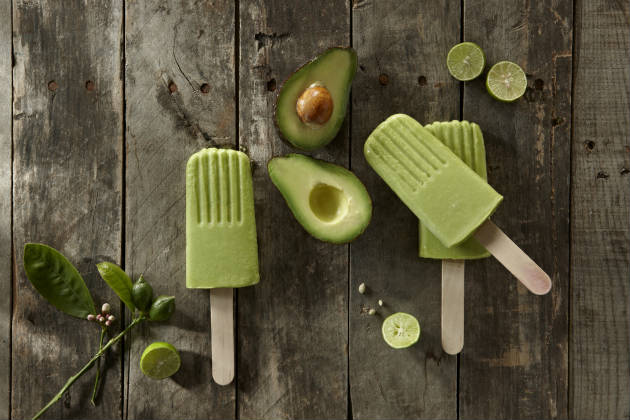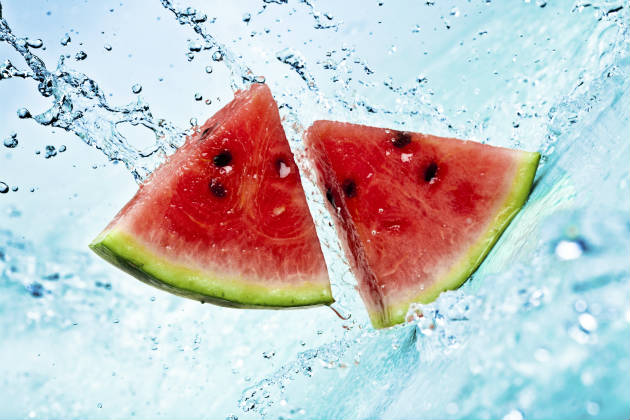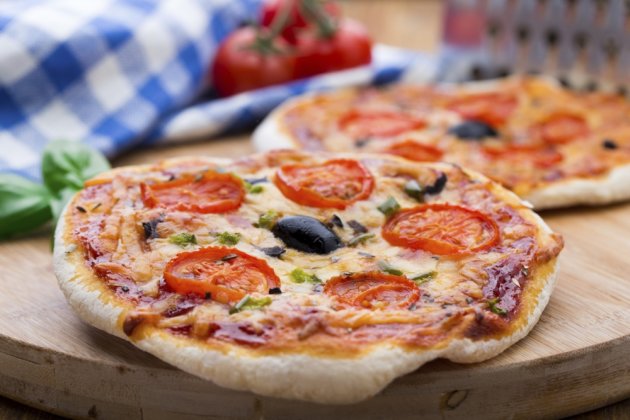Just because you’re working on toning up your body, doesn't mean you can’t enjoy deliciously indulgent foods. These super healthy desserts are amazing at building muscle, and all taste fantastic to boot.
 Avocado ice lolly
Avocado ice lollyAvocado ice cream
Don’t be put off by the high fat content of avocados – around 70% of that fat content is made up of monounsaturated fats, which help to prevent the breakdown of muscle. A 2014 Swedish study showed that people with higher amounts of unsaturated fat in their diet displayed lower fat levels and more muscle than those who ate primarily saturated fats.
Although it might sound like an alien concept, avocado actually tastes delicious when used to make light and creamy avocado ice lollies. All you need to do is blend avocado up with almond milk, lime juice and a pinch of sugar (or natural sweetener) until smooth, and then throw the mixture into moulds in the freezer. Alternatively, swap the almond milk for cream and put the mixture into an ice cream maker, and you’ve got avocado ice cream.
Quinoa pancakes
While pancakes are a delicious and filling way to round off a meal or start your day, they’re also making you fat without you even realising. the refined carbohydrates often found in pancakes can lead to increased cravings for food throughout the day.
Luckily, these red quinoa pancakes solve that problem, while adding an extra muscle-building boost to this fluffy dessert. Coconut oil and coconut milk are used instead of regular milk and butter, and sugar is taken out of the equation by adding coconut palm sugar. Add red quinoa to the pancake mixture before cooking to give an extra bite and zest to the dish.
Quinoa is a fantastic source of muscle-friendly protein. It’s also unique in that it contains the full range of essential amino acids, which combine to fight off free radicals within the body and improve muscle development.
Pineapple and banana sorbet
If you want to build muscle and you’re planning to start hitting the gym hard, you absolutely have to add pineapple to your diet. Not only is it high in vitamin C to speed up muscle recovery, pineapple also contains bromelain, which helps with protein digestion and reduces muscle inflammation.
You can make a delicious pineapple and banana sorbet by blending pineapple chunks with banana, lime juice and sugar, and then chilling the mixture for three hours before running it through an ice cream maker.
The banana in this tasty sorbet gives you an extra muscle-building bonus. Bananas are great for maintaining optimum glycogen levels, which slows down the break up of protein reserves in your muscle tissue.
Coconut milk milkshakes
Put a healthy, muscle-toning twist on normal milkshakes by creating a delicious coconut milk milkshake. It couldn’t be easier to prepare – if you've got coconut milk, banana, vanilla, honey, ice cubes and a blender then you can’t go wrong.
Coconut milk is all about keeping your muscles in peak condition. Its high level of magnesium helps to reduce post-workout muscle soreness and improve the health of your nervous system. Your joints and bones will become stronger as well, because coconut milk contains phosphorous, which works in tandem with calcium to increase bone strength.
Peanut butter protein balls
A tasty dessert that takes 10 minutes to make, doesn't require any baking, and provides a double hit of protein to build muscle – sound too good to be true? Then you haven’t tried these delicious peanut butter protein balls yet.
It’s just a case of mixing up protein powder, ground nuts, peanut butter and agave nectar (we’d suggest skipping the chocolate chips) into bite-size balls, and then popping them in the fridge.
The protein powder provides the main body-toning power of this dessert, but peanut butter is no slouch either. Each tablespoon of natural peanut butter contains 3.5g of protein, as well as poly- and monounsaturated fats.
Spinach and blueberry smoothie
Seems there really was some truth behind Popeye’s penchant for spinach. In a study at Rutgers University, researchers identified a type of phytoecdysteroid found in spinach that boosts muscle development by 20 per cent.
You can enjoy spinach in dessert form with this sweet but super healthy spinach and blueberry smoothie. Simply whizz some fresh spinach up in a blender with fresh blueberries, a banana, and the fruit juice of your choice – both apple and pomegranate juice work really well.
As well as covering up the distinct taste of spinach, blueberries are packed full of antioxidants, and contain polyphenols, which reduce inflammation and increase muscle recovery rate.
Cottage cheese fruit salad
Cottage cheese has long been a favourite snack of gym-addicts, and for good reason. Because it’s so high in protein (a whopping 25g of protein per 200g serving), cottage cheese increases your body’s production of natural growth hormone. This hormone was found to be a major contributor to both muscle gain and fat loss in a 2009 study published in the Journal of Clinical Endocrinology.
With it’s tangy, salty taste, cottage cheese isn’t up everyone’s street, so try sweetening it up by adding it to a fruit salad. Make sure you mix in the cottage cheese well in advance of eating it, as this gives the cheese plenty of time to absorb the sweet flavours of the fruit.https://uk.lifestyle.yahoo.com/7-amazing-body-toning-desserts-080015083.html





